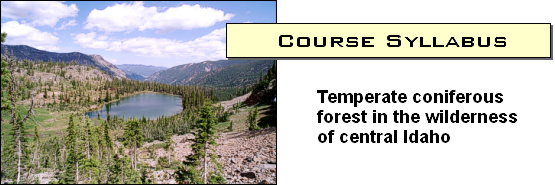 |
|
Professor Emeritus R. Robberecht College of Natural Resources | University of Idaho Moscow, Idaho 83844-1133 USA
Ecology@uidaho.edu
|
Quick index |
|
|
 |
|
Professor Emeritus R. Robberecht College of Natural Resources | University of Idaho Moscow, Idaho 83844-1133 USA
Ecology@uidaho.edu
|
Quick index |
|
|
|
||||||||||||||||||||||
|
|
|
Event |
Date | *Exam period: 8 a.m. - midnight |
| Examination I (1 hour) | Monday, February 24 |
| Examination II (1 hour) | Friday, March 30 |
|
Final examination (2
hours, comprehensive) Students can take extra time on all examinations |
Monday, May 11 |
|
Quizzes can be taken at your own schedule, but the recommended completed dates are: |
|
| Quizzes 1 - 5 | February 21 |
| Quizzes 6 - 12 | March 27 |
| Quizzes 13 - 16 | May 8 |
| *For on-campus students, all assessments will be proctored by the professor (or assistant), by appointment. | |
|
Event |
Percent |
Final Grade |
|
| Examination I |
25% |
A | (90-100%) |
| Examination II |
25% |
B | (80-89%) |
| Quizzes (based on 10 quizzes**) |
15% |
C | (70-79%) |
| Final examination |
35% |
D | (60-69%) |
|
Total |
100% |
F | (< 60%) |
|
**All quizzes and examinations use the
Blackboard
Learn
system and must be proctored in a secure setting. **Only the top 10 scores from the 16 quizzes will be used in your course grade. |
|||
| Note. The grade level of "A" represents outstanding performance on the examinations, and the attainment of high competence in the basic principles of ecology and the student learning objectives listed above. |
Important dates
|
Event | UI calendar of events |
Date |
| Course begins | January 15 |
| Martin Luther King - Idaho Human Rights Day - UI closed | January 20 |
| Final date to withdraw from courses without a grade of "W" | January 29 |
| President's Day - UI closed | February 17 |
| Spring recess - UI closed | March 16 - 20 |
| Final date for withdrawal from course with a grade of "W" | April 3 |
| Course ends | May 15 |
A. History
1. Origins and scope of ecology
a. Major ecologists and organizations
A. The nature of species
1. Definitions and scope
B. Relationships to the abiotic environment
C. Range of the optimum
1. Liebig's Law of the Minimum
D. Phenotype and genotype E. Acclimation and adaptation F. Energy balance G. Animal behavior
H. Evolutionary considerations
1. Fitness
A. Energy balance
1. Solar and terrestrial radiation [Solar
radiation |
Photobiology]
a. Influence of slope and aspect
4. Terrestrial versus aquatic environments
B. The response of organisms to their environment 1. Water relations of organisms a. Terrestrial and aquatic water supplies i. Soil water content
a. Light, nutrients, water factors 3. Oxygen exchange and respiration a. Adaptations in plants and animals
A. Structure of populations
1. Birth and death, distribution, dispersion, and density
B. Growth of populations
1. Biotic potential or intrinsic rate of increase
C. Regulation of populations
1. Density-dependent and density-independent regulation
D. Fluctuations and cycles of populations
E. Evolutionary considerations
1. Natural selection
F. Human population structure and growth
1. Trends and consequences
A. Interactions between and among species
1. Intra- and inter-specific interactions
B. Herbivory and predation
1. Trophic interactions
a. Plant response to herbivory
4. Types of predators
a. Predator-prey models
C. Parasitism, commensalism, protocooperation, and saprobism
1. Parasitism
a. Types and prevalence of parasites
2. Commensalism, protocooperation, and saprobism
a. Examples
D. Neutralism and amensalism 1. Definitions and examples
E. Allelopathy and competition
1. Allelopathy
a. Definition, occurrence, and examples
2. Competition
a. Definition and occurrence
i. The concept of niche and guild
F. Mutualism
1. Definition and types of mutualism
A. The concept of community
1. Definitions of a community
B. Community structure
1. Dominance
C. The niche concept and biodiversity
1. Fundamental versus realized niche
D. Community organization and the role of competition
E. The integrated versus individualistic community
1. Comparisons with discrete and continuum theories
F. Diversity indices
A. Definition and concepts of the community B. Types of community change C. Analysis of plant communities
1. Development of communities
a. Succession
i. Primary and secondary succession
2. Structure and development of animal communities
D. Types of communities
1. Major communities types of the world
A. Ecosystem and biome concepts
1. History and examples
B. Humans and ecosystems
1. Global environmental problems
a. Stratospheric ozone depletion
C. Trophic levels and food webs
1. Ecosystem energetics
D. Energy flow and productivity
1. Energy flow through trophic levels
E. Influence of humans on ecosystem processes
F. Biogeochemical cycling
1. Carbon cycle
A. Introduction
1. Physiognomy B. Terrestrial ecosystems & biomes C. Aquatic ecosystems & biomes D. Global change: Ecosystems & biomes
|
||||||||||||||||||||||||||||||||||||||||||||||||||||||||||||||||||||||||||||||||||||||||||